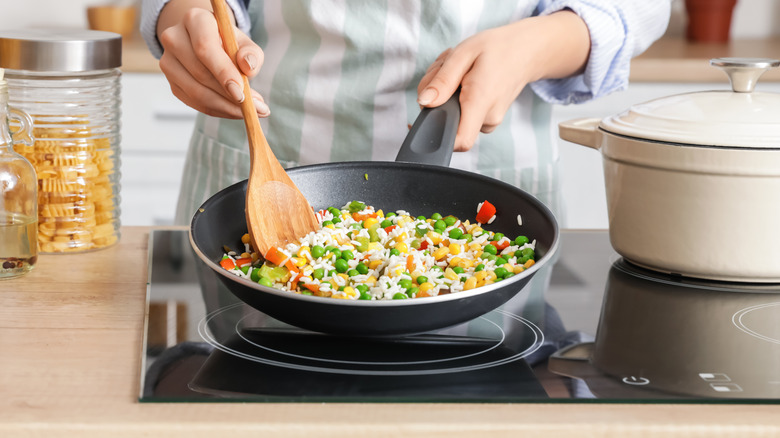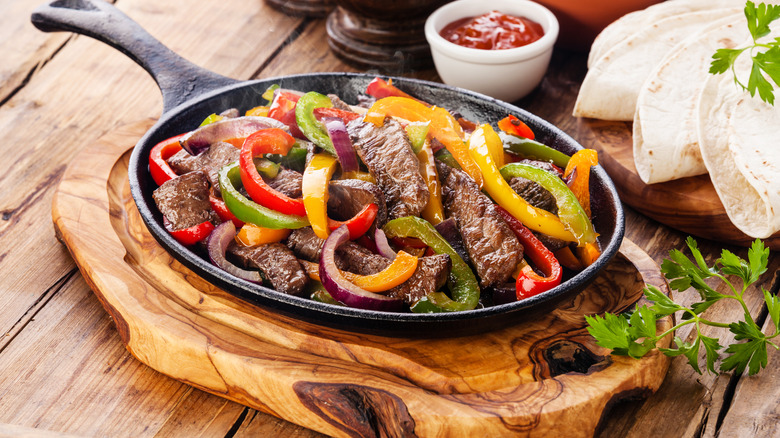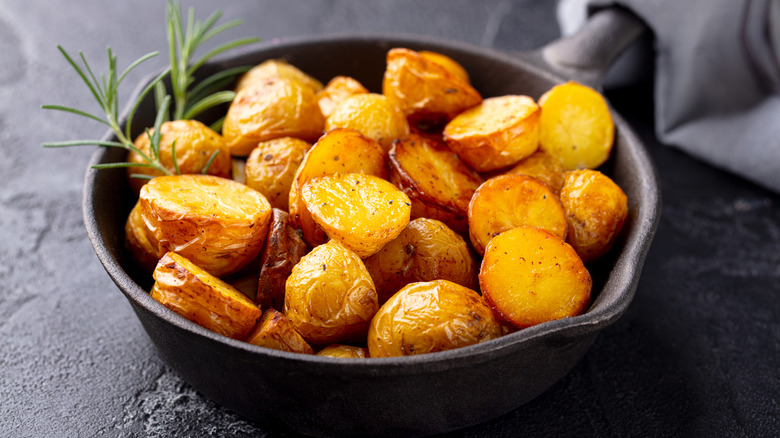What's The Difference Between A Skillet And A Pan?
Anyone who's ever spent any significant time in the kitchen knows that different pans have different uses. Oftentimes, these uses are obvious. A grill pan is clearly suited to bringing the charred, smoky flavors of outdoor cooking indoors. Nonstick pans make cleaning up a breeze. Sauté pans are — you guessed it — great for sautéing. But other pans' strengths and weaknesses can be a little more tricky to figure out. This is exacerbated by the fact that many of them are easy to use interchangeably.
Sure, the distinctly named sauté pan is intended for sautéing, but if your griddle's soaking in the sink and you've got an unignorably intense craving for pancakes, you can absolutely substitute it successfully. Sometimes, using pans in unexpected ways can even be the secret to a great dish: Heavy-duty Dutch ovens are the key to delectable pasta.
Still, it's worth paying attention to different pans' specific uses. Something that can maintain a steady temperature will give you the most consistent results when deep-frying, for example, while searing veggies in a wok will give them a unique smoky flavor. Knowing the difference between skillets and frying pans is especially useful — but few people understand what truly sets these two cooking vessels apart.
Skillets vs. frying pans
Skillets and frying pans look pretty similar to the untrained eye. They're both wide, shallow pans with long handles, intended to be used on a range. There's a good chance you've used them interchangeably in the past: Both are great at browning grilled cheeses, frying hash browns, and searing a steak. But these aren't actually identical pans, and learning their distinct differences might be the key to taking your kitchen game to the next level.
According to MasterClass, skillets are distinguished by their increased depth and sloped sides. Though they're made out of a variety of materials, the cast iron skillet is a culinary icon with a passionate following of professional and home cooks. This particular pan is remarkably heavy and requires specialized care, but devotees are more than willing to put in the necessary work. Frying pans, in contrast, are thinner and shallower than skillets and have rounded sides. They're also manufactured out of a wide range of materials, ranging from stainless steel to copper. Though cast iron frying pans aren't quite as famous as cast iron skillets, they also have their fans.
The power of a particular pan
The differences between skillets and frying pans might seem minor, but paying attention to them can make an enormous difference in your cooking. Per MasterClass, skillets' greater depth and sloped sides make them a bit more versatile: You can use a skillet to fry something delicate, but you can also use it to toss a stir-fry together, without fear of sending ingredients flying out of the pan. The classic cast iron skillet has even more uses, as it retains heat for impressive lengths of time and can even go directly into the oven. This means you can fry up a hearty breakfast and bake a decadent dessert in one trusty pan.
Frying pans' shallower depth and thinner construction confine them to a narrower range of uses than that of the mighty skillet. But these attributes also make them absolutely excellent at what they're specifically meant for — frying. By putting less metal between the flame and your food, frying pans can help a home cook achieve the perfect fried chicken, fried eggs, or fried rice. Many are also made of cast iron, which helps them go the distance during marathon frying sessions.
So yes, you can use a skillet and a frying pan fairly interchangeably. But if you want to take your cooking — and even your baking, if you're using cast iron — to the next level, you might decide it's worth paying a little more attention to which pan you've got in hand.


